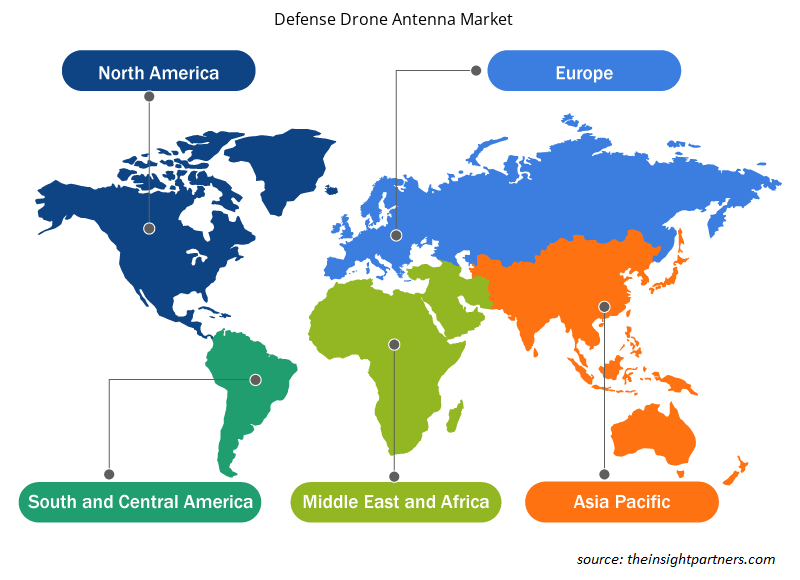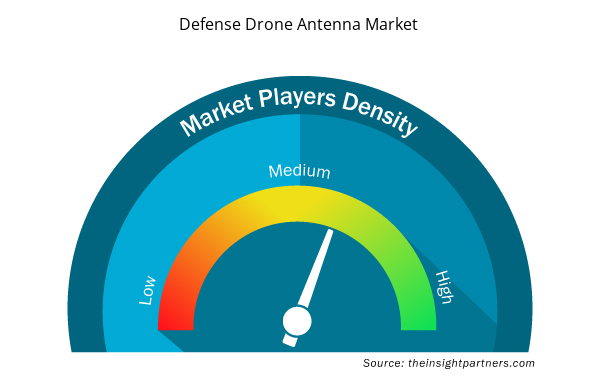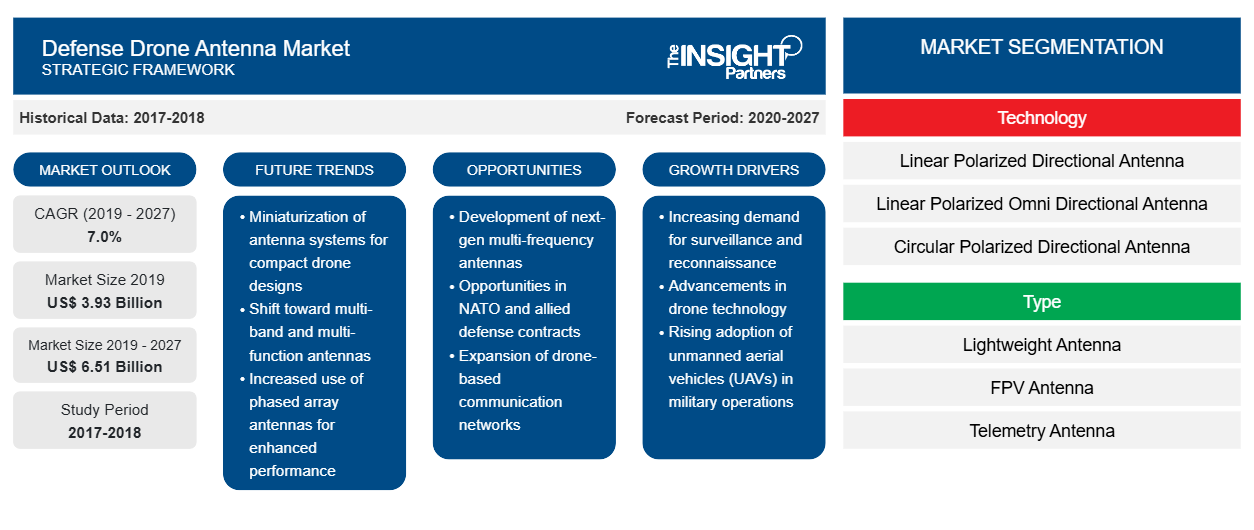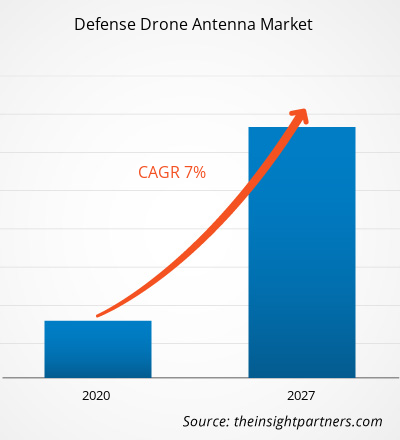In termini di fatturato, il mercato globale delle antenne per droni da difesa è stato valutato a 3.925,61 milioni di dollari nel 2019 e si prevede che raggiungerà i 6.505,28 milioni di dollari entro il 2027; si prevede una crescita a un CAGR del 7,0% nel periodo di previsione dal 2020 al 2025.
Il mercato delle antenne per droni da difesa è ampiamente segmentato in cinque regioni principali: Nord America, Europa, APAC, MEA e SAM. Il Nord America domina il mercato degli UAV militari. Pertanto, la domanda di antenne per droni da difesa dalla regione è elevata. Gli attori e il governo negli Stati Uniti stanno investendo in modo significativo in R&S relativa agli UAV militari. Oltre a ciò, le collaborazioni tra i giganti del settore, insieme ai crescenti investimenti nello sviluppo di UAV tecnologicamente avanzati per supportare molte applicazioni militari, accelereranno la domanda di UAV militari negli Stati Uniti.
Personalizza questo report in base alle tue esigenze
Riceverai la personalizzazione gratuita di qualsiasi report, comprese parti di questo report, o analisi a livello nazionale, pacchetto dati Excel, oltre a usufruire di grandi offerte e sconti per start-up e università
- Scopri le principali tendenze di mercato in questo rapporto.Questo campione GRATUITO includerà analisi di dati che spaziano dalle tendenze di mercato alle stime e alle previsioni.
Approfondimenti di mercato: mercato delle antenne per droni di difesa
Cresce l'interesse per le antenne omnidirezionali circolari
Le forze militari utilizzano tecnologie senza pilota per scopi quali sorveglianza, comunicazioni, navigazione e intelligence del segnale (SIGINT). Le forze militari sono costantemente alla ricerca di tecnologie avanzate con l'obiettivo di migliorare le capacità dei veicoli senza pilota. Le antenne omnidirezionali a polarizzazione lineare sono tra le tecnologie di antenna preferite. Tuttavia, la preferenza per le antenne omnidirezionali a polarizzazione circolare sta aumentando a un ritmo esponenziale. I droni militari moderni devono muoversi o manovrare costantemente per raccogliere volumi maggiori di informazioni; quindi, a volte devono adottare il volo acrobatico. Le antenne circolari sono più piccole, il che offre un ulteriore vantaggio per una facile manovrabilità. Oltre alle dimensioni ridotte dell'antenna, la capacità di trasmettere i dati raccolti a 360° sta suscitando interesse da parte delle forze di difesa e dei produttori di droni da difesa. Inoltre, le forze militari richiedono una qualità eccezionale di dati e immagini catturati tra le forze militari e queste antenne facilitano la trasmissione di immagini di alta qualità durante il volo del drone in prossimità del bersaglio. Tali vantaggi delle antenne omnidirezionali circolari stanno contribuendo alla crescita del mercato delle antenne per droni da difesa.
Approfondimenti sul segmento tecnologico
Sulla base della tecnologia, il segmento delle antenne omnidirezionali a polarizzazione lineare ha dominato il mercato globale delle antenne per droni da difesa nel 2019. Le antenne lineari proiettano un'onda lungo un piano singolare, orizzontale o verticale. Questo tipo di polarizzazione facilita la trasmissione di più energia, poiché l'onda si muove semplicemente in una direzione.
Tipo Segmento Insights
In base al tipo, il segmento delle antenne leggere ha dominato il mercato globale delle antenne per droni da difesa nel 2019. UAV più piccoli e leggeri vengono utilizzati in modo significativo per applicazioni di intelligence e comunicazioni più complesse. Per aumentare la competenza di vagabondaggio e la persistenza di questi veicoli, c'è una crescente richiesta di antenne più leggere e più aerodinamiche.
Informazioni sul segmento di frequenza
In base alla frequenza, il segmento di frequenza ultra-alta ha dominato il mercato globale delle antenne per droni da difesa nel 2019. Le antenne a frequenza ultra-alta (UHF) operano con una gamma di frequenza superiore a 300 Mhz. Nello scenario attuale, UHF è la banda di frequenza più comunemente utilizzata.
Approfondimenti sui segmenti applicativi
In base al settore, il segmento delle comunicazioni ha dominato il mercato globale delle antenne per droni da difesa nel 2019. I produttori di UAV stanno costantemente sottolineando, integrando sistemi di comunicazione all'avanguardia con l'obiettivo di facilitare il personale militare presso la stazione base per comunicare con l'UAV. Per integrare i migliori sistemi di comunicazione, la necessità di un'antenna di comunicazione è di fondamentale importanza. Attribuendo al fatto che l'importanza dell'antenna di comunicazione su un UAV, si prevede che la domanda di antenna rimarrà elevata per tutto il periodo di previsione.
Gli operatori del mercato si concentrano su innovazioni e sviluppi di nuovi prodotti integrando tecnologie e funzionalità avanzate nei loro prodotti per competere con i concorrenti.
- Nel 2020, PPM ha annunciato l'apertura di 40 nuovi uffici nel Regno Unito per espandere le sue attività di ingegneria e progettazione, vendite e marketing, servizio clienti e contabilità.
- Nel 2020, Southwest Antennas ha introdotto due nuove antenne omnidirezionali per l'uso in applicazioni UHF e ISM. Sono ideali per sistemi radio tattici, ricevitori video portatili, sistemi radio MIMO e MANET, piattaforme robotiche senza pilota e altre applicazioni. Le nuove antenne sono disponibili con base a molla sigillata Ultra-Flex o base flessibile a collo d'oca.
Approfondimenti regionali sul mercato delle antenne per droni da difesa
Le tendenze regionali e i fattori che influenzano il mercato delle antenne per droni da difesa durante il periodo di previsione sono stati ampiamente spiegati dagli analisti di Insight Partners. Questa sezione discute anche i segmenti e la geografia del mercato delle antenne per droni da difesa in Nord America, Europa, Asia Pacifico, Medio Oriente e Africa e Sud e Centro America.

- Ottieni i dati specifici regionali per il mercato delle antenne per droni da difesa
Ambito del rapporto sul mercato delle antenne per droni di difesa
| Attributo del report | Dettagli |
|---|---|
| Dimensioni del mercato nel 2019 | 3,93 miliardi di dollari USA |
| Dimensioni del mercato entro il 2027 | 6,51 miliardi di dollari USA |
| CAGR globale (2019 - 2027) | 7,0% |
| Dati storici | 2017-2018 |
| Periodo di previsione | 2020-2027 |
| Segmenti coperti | Per tecnologia
|
| Regioni e Paesi coperti | America del Nord
|
| Leader di mercato e profili aziendali chiave |
|
Densità degli attori del mercato: comprendere il suo impatto sulle dinamiche aziendali
Il mercato delle antenne per droni da difesa sta crescendo rapidamente, spinto dalla crescente domanda degli utenti finali dovuta a fattori quali l'evoluzione delle preferenze dei consumatori, i progressi tecnologici e una maggiore consapevolezza dei vantaggi del prodotto. Con l'aumento della domanda, le aziende stanno ampliando le loro offerte, innovando per soddisfare le esigenze dei consumatori e capitalizzando sulle tendenze emergenti, il che alimenta ulteriormente la crescita del mercato.
La densità degli operatori di mercato si riferisce alla distribuzione di aziende o società che operano in un particolare mercato o settore. Indica quanti concorrenti (operatori di mercato) sono presenti in un dato spazio di mercato in relazione alle sue dimensioni o al valore di mercato totale.
Le principali aziende che operano nel mercato delle antenne per droni da difesa sono:
- Società controllata da Alaris Holdings Ltd.
- Società Antcom
- Antenna Research Associates, Inc.
- Società Cobham
- Ingegneria JEM
Disclaimer : le aziende elencate sopra non sono classificate secondo un ordine particolare.

- Ottieni una panoramica dei principali attori del mercato delle antenne per droni da difesa
Il mercato globale delle antenne per droni da difesa è stato segmentato come segue:
Mercato delle antenne per droni di difesa – Per tecnologia
- Antenna direzionale polarizzata lineare
- Antenna omnidirezionale a polarizzazione lineare
- Antenna direzionale polarizzata circolare
- Antenna omnidirezionale polarizzata circolare
Mercato delle antenne per droni da difesa – Per tipo
- Antenna leggera
- Antenna FPV
- Antenna di telemetria
- Antenna NLOS
- Altri
Mercato delle antenne per droni da difesa – Per frequenza
- Alta frequenza
- Frequenza molto alta
- Frequenza ultra-alta
Mercato delle antenne per droni di difesa – per applicazione
- Sorveglianza
- Navigazione
- Comunicazione
- Telemetria
- Altri
Mercato delle antenne per droni da difesa - per regione
- America del Nord
- NOI
- Canada
- Messico
- Europa
- Francia
- Germania
- Italia
- Spagna
- Svizzera
- Regno Unito
- Resto d'Europa
- Asia Pacifico (APAC)
- Cina
- India
- Corea del Sud
- Singapore
- Giappone
- Australia
- Resto dell'APAC
- Medio Oriente e Africa (MEA)
- Sudafrica
- Arabia Saudita
- Emirati Arabi Uniti
- Resto del MEA
- America del Sud (SAM)
- Brasile
- Resto del SAM
Mercato delle antenne per droni di difesa – Profili aziendali
- Società controllata da Alaris Holdings Ltd.
- Società Antcom
- Antenna Research Associates, Inc.
- Società Cobham
- Ingegneria JEM
- Antenna MP, LTD
- Sistemi PPM
- Antenne del sud-ovest, Inc.
- Connettività TE
- Trimble Inc.
- Analisi storica (2 anni), anno base, previsione (7 anni) con CAGR
- Analisi PEST e SWOT
- Valore/volume delle dimensioni del mercato - Globale, regionale, nazionale
- Industria e panorama competitivo
- Set di dati Excel



Report Coverage
Revenue forecast, Company Analysis, Industry landscape, Growth factors, and Trends

Segment Covered
This text is related
to segments covered.

Regional Scope
North America, Europe, Asia Pacific, Middle East & Africa, South & Central America

Country Scope
This text is related
to country scope.
Domande frequenti
The linear polarized omni directional antenna segment led the technology segment. The linear antennas project a wave along a singular plane, horizontal or vertical. This kind of polarization facilitates more energy to be transmitted, as the wave simply moves in one direction. However, penetration of obstacles is reduced pertaining to the difficulty a linear wave faces in navigating around an object that is present in its plane of propagation. On the other hand, omnidirectional antennas are best suitable for the radiation of a signal in all possible directions, but over a comparatively shorter range. The radiation pattern can be clearly captured in the omnidirectional antennas as being particularly well dispersed in all the directions covering the antenna apart from directly below and above the antenna. These antennas are mainly utilized with the video transmitter, as the antennas are well adapted to overcome unexpected changes in the direction and attitude of an aircraft’s flight.
North America is expected to be the largest revenue generator in the defense drone antenna market compared to the other regions. The US Department of Defense (DoD) is anticipated to increase its UAV spending in the next few years to prepare the military for high-end fights against advanced rivals. There was an inclusion of the spending of US$ 3.7 billion on new unmanned systems technology in the president defense budget request for FY 2020. According to the dean of the Mitchell Institute for Aerospace Studies, the US military has enormous opportunities to use UAVs more commonly in various applications, including cargo aircraft and combat aircraft. The growing demand for drones for military application in North America is expected to drive the growth of defense drone antenna market.
A rapidly changing modern warfare has been urging governments of various countries to allocate higher amounts toward the respective military forces. The military budget allocation enables the military forces to procure advanced technologies and equipment from national or international manufacturers. On the same lines, solider and military vehicle modernization practices are also on rise in many countries. The procurement of drones or unmanned aerial vehicles (UAVs) is a major part of this modernization strategy. In addition, the defense ministries worldwide are investing substantial amounts in newer technologies, including contemporary UAVs or unmanned aircraft systems (UAS). Surge in orders for the drones or UAVs or UASs from the defense forces signifies a substantial demand for drone antennas, which is driving the defense drone antenna market.
Trends and growth analysis reports related to Aerospace and Defense : READ MORE..
The List of Companies - Defense Drone Antenna Market
- Alaris Holdings Ltd.
- Antcom Corporation
- Antenna Research Associates, Inc.
- Cobham Plc
- JEM Engineering
- MP Antenna, LTD
- PPM Systems
- Southwest Antennas, Inc.
- TE Connectivity
- Trimble Inc.
The Insight Partners performs research in 4 major stages: Data Collection & Secondary Research, Primary Research, Data Analysis and Data Triangulation & Final Review.
- Data Collection and Secondary Research:
As a market research and consulting firm operating from a decade, we have published and advised several client across the globe. First step for any study will start with an assessment of currently available data and insights from existing reports. Further, historical and current market information is collected from Investor Presentations, Annual Reports, SEC Filings, etc., and other information related to company’s performance and market positioning are gathered from Paid Databases (Factiva, Hoovers, and Reuters) and various other publications available in public domain.
Several associations trade associates, technical forums, institutes, societies and organization are accessed to gain technical as well as market related insights through their publications such as research papers, blogs and press releases related to the studies are referred to get cues about the market. Further, white papers, journals, magazines, and other news articles published in last 3 years are scrutinized and analyzed to understand the current market trends.
- Primary Research:
The primarily interview analysis comprise of data obtained from industry participants interview and answers to survey questions gathered by in-house primary team.
For primary research, interviews are conducted with industry experts/CEOs/Marketing Managers/VPs/Subject Matter Experts from both demand and supply side to get a 360-degree view of the market. The primary team conducts several interviews based on the complexity of the markets to understand the various market trends and dynamics which makes research more credible and precise.
A typical research interview fulfils the following functions:
- Provides first-hand information on the market size, market trends, growth trends, competitive landscape, and outlook
- Validates and strengthens in-house secondary research findings
- Develops the analysis team’s expertise and market understanding
Primary research involves email interactions and telephone interviews for each market, category, segment, and sub-segment across geographies. The participants who typically take part in such a process include, but are not limited to:
- Industry participants: VPs, business development managers, market intelligence managers and national sales managers
- Outside experts: Valuation experts, research analysts and key opinion leaders specializing in the electronics and semiconductor industry.
Below is the breakup of our primary respondents by company, designation, and region:

Once we receive the confirmation from primary research sources or primary respondents, we finalize the base year market estimation and forecast the data as per the macroeconomic and microeconomic factors assessed during data collection.
- Data Analysis:
Once data is validated through both secondary as well as primary respondents, we finalize the market estimations by hypothesis formulation and factor analysis at regional and country level.
- Macro-Economic Factor Analysis:
We analyse macroeconomic indicators such the gross domestic product (GDP), increase in the demand for goods and services across industries, technological advancement, regional economic growth, governmental policies, the influence of COVID-19, PEST analysis, and other aspects. This analysis aids in setting benchmarks for various nations/regions and approximating market splits. Additionally, the general trend of the aforementioned components aid in determining the market's development possibilities.
- Country Level Data:
Various factors that are especially aligned to the country are taken into account to determine the market size for a certain area and country, including the presence of vendors, such as headquarters and offices, the country's GDP, demand patterns, and industry growth. To comprehend the market dynamics for the nation, a number of growth variables, inhibitors, application areas, and current market trends are researched. The aforementioned elements aid in determining the country's overall market's growth potential.
- Company Profile:
The “Table of Contents” is formulated by listing and analyzing more than 25 - 30 companies operating in the market ecosystem across geographies. However, we profile only 10 companies as a standard practice in our syndicate reports. These 10 companies comprise leading, emerging, and regional players. Nonetheless, our analysis is not restricted to the 10 listed companies, we also analyze other companies present in the market to develop a holistic view and understand the prevailing trends. The “Company Profiles” section in the report covers key facts, business description, products & services, financial information, SWOT analysis, and key developments. The financial information presented is extracted from the annual reports and official documents of the publicly listed companies. Upon collecting the information for the sections of respective companies, we verify them via various primary sources and then compile the data in respective company profiles. The company level information helps us in deriving the base number as well as in forecasting the market size.
- Developing Base Number:
Aggregation of sales statistics (2020-2022) and macro-economic factor, and other secondary and primary research insights are utilized to arrive at base number and related market shares for 2022. The data gaps are identified in this step and relevant market data is analyzed, collected from paid primary interviews or databases. On finalizing the base year market size, forecasts are developed on the basis of macro-economic, industry and market growth factors and company level analysis.
- Data Triangulation and Final Review:
The market findings and base year market size calculations are validated from supply as well as demand side. Demand side validations are based on macro-economic factor analysis and benchmarks for respective regions and countries. In case of supply side validations, revenues of major companies are estimated (in case not available) based on industry benchmark, approximate number of employees, product portfolio, and primary interviews revenues are gathered. Further revenue from target product/service segment is assessed to avoid overshooting of market statistics. In case of heavy deviations between supply and demand side values, all thes steps are repeated to achieve synchronization.
We follow an iterative model, wherein we share our research findings with Subject Matter Experts (SME’s) and Key Opinion Leaders (KOLs) until consensus view of the market is not formulated – this model negates any drastic deviation in the opinions of experts. Only validated and universally acceptable research findings are quoted in our reports.
We have important check points that we use to validate our research findings – which we call – data triangulation, where we validate the information, we generate from secondary sources with primary interviews and then we re-validate with our internal data bases and Subject matter experts. This comprehensive model enables us to deliver high quality, reliable data in shortest possible time.


 Ottieni un campione gratuito per questo repot
Ottieni un campione gratuito per questo repot